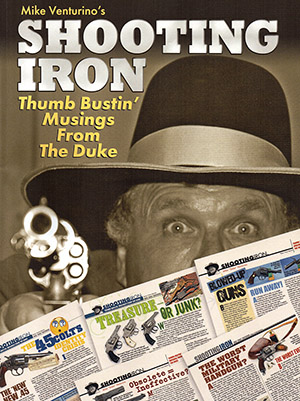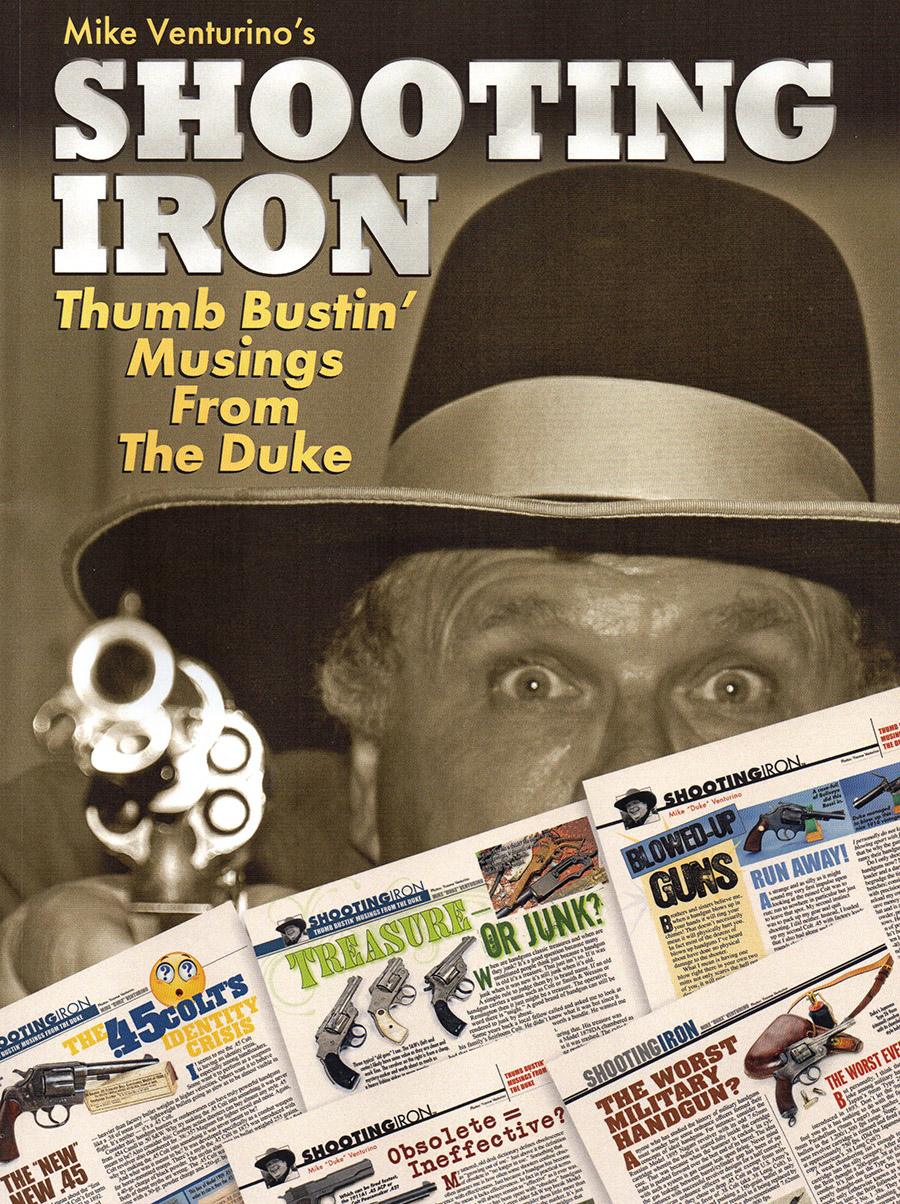By Joe Berk
Mike Venturino was one of the greatest gun writers who ever lived. Whenever I’d see his byline in a gun magazine, I would carefully read every word in the accompanying article. He was a guy who wrote about things that exactly matched my interests: Handguns, rifles, military surplus weaponry, reloading, reloading for accuracy, and more. His style was relaxed and friendly, and his writing was easy to follow and understand. I felt like I knew the guy, even though we had never met. His writing style, I’m sure, influenced mine.
 Mike Venturino passed away recently, and FMG Publications assembled a collection of his articles originally published in American Handgunner magazine. As soon as I heard about Shooting Iron, I ordered a couple of copies on Amazon (one for me, and one for a good friend). If you like good writing, good storytelling, and all things firearms related, I think you should pick up a copy, too. You can order Shooting Iron here.
Mike Venturino passed away recently, and FMG Publications assembled a collection of his articles originally published in American Handgunner magazine. As soon as I heard about Shooting Iron, I ordered a couple of copies on Amazon (one for me, and one for a good friend). If you like good writing, good storytelling, and all things firearms related, I think you should pick up a copy, too. You can order Shooting Iron here.
As I read through Shooting Iron, I came across two descriptions in which Venturino described blowing up a 9mm handgun. You may recall that I did the same, and I shared that experience with you here and here. Based on what Venturino wrote and what I experienced, I am rethinking my 9mm 1911 Springfield blow up. I previously concluded that I must have had a double charge in one of the cartridges (particularly because I was using a new turret press). Now I am thinking that wasn’t it at all, but it was instead the bullet being pushed back into the case. This is based on the following:
-
- I was using powder coated Gardner bullets, which are very slippery. It’s would have been easy to push one of them back into the case if the crimp was not strong. I don’t know if I had a really tight crimp when I loaded the round that burst. I use a very strong crimp now. Back then, I don’t know if I did.
- I checked about 1500 cartridges after that event (ones I had previously loaded but not fired) by pulling them apart and examining the charge. None were double charged. That doesn’t prove I didn’t double charge one, but it suggests it was unlikely.
- In reading the articles in Shooting Iron, I found where Venturino describes the 9mm bullet pushback phenomenon in two places (when you buy your copy, take a look at Pages 32 and 63). On Page 32, he describes this having occurred with a 9mm round, and he shows a burst case that looks just like mine. He further describes this episode with “…the escaping gas spitting (he probably meant splitting) the two grip panels and stinging my hand.” That’s precisely what I experienced. On Page 63, Venturino shows a burst case that looks like my case. I don’t know if the two instances described in the book are the same event. They both sound like what I experienced.
The bottom line is I don’t know exactly what happened when I blew up my 9mm 1911 and I never will. But after reading Mike Venturino’s Shooting Iron experiences, I am more convinced it was a bullet being pushed back into the case. In either event (bullet pushback or a double charge), I’m guilty of careless reloading, but somehow messing up on the crimp makes me feel less dumb than double charging a case. And I especially feel less dumb knowing that one of my literary heroes (Mike Venturino) did the same thing.
Never miss an ExNotes blog:



That’s how your brain works. You come up with a foolproof, very methodical system designed to eliminate errors and you go with it. And it works, no need to check further. But, in your case, unless you microscopically double check or even triple check each and every bullet, one bad bullet out of thousands can slip by. You’ve probably done it before only there weren’t any consequences. You notice it only when there are consequences. Could you not make up some sort of jig for the particular bullet you are loading so you can quickly insert it to measure it without resorting to instruments? Or maybe lock down a vernier caliper at a specific opening and pass the bullet through to see if you pushed the slug in too far.
All good points, Marcus. If you’re referring to the one time I blew up a 9mm 1911, I don’t think it was the bullet diameter; I think it was the crimp, and all the bullets’ (bullets plural, not just one) reduced coefficient of friction (due to a very slippery powder coat) aggravated the situation. But the real culprit was a mildly inconsistent crimp due to variations in case length and case mouth wall thickness. I didn’t trim the brass and I was using mixed brass on that particular batch of ammo. Normally, it wouldn’t matter that much, but with the super slippery bullets, a weaker crimp allowed the bullet to be pushed back into the case. I don’t use those bullets anymore, and I apply a stronger crimp. I don’t think that a jig would be an effective inspection tool here. Your comments are good ones, and it made me think more about this issue.
These days, I’m chasing wild velocity variations in .38 Special ammo using Xtreme copper plated bullets. That’s a story for a future blog.
Thanks for commenting, Marcus, and best wishes for a great holiday season.
Thanks, same to you Joe. Best of health. Interesting times ahead. Cheers.